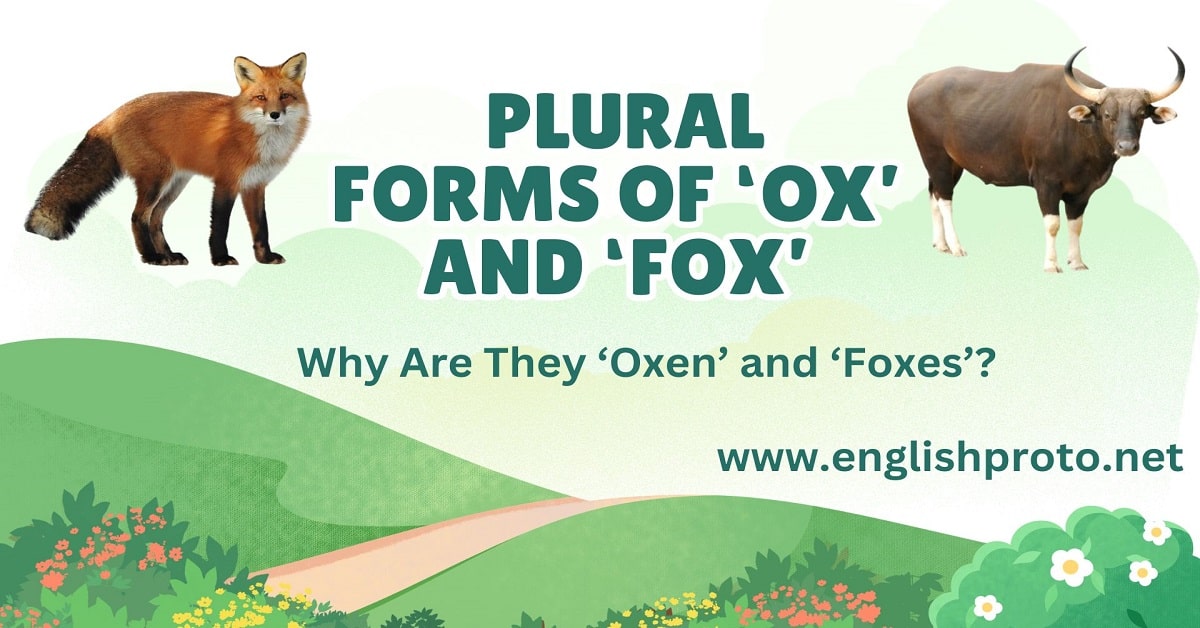What Are the Plural Forms of ‘Ox’ and ‘Fox,’ and Why Are They ‘Oxen’ and ‘Foxes’? If you’ve ever wondered about these peculiar plural forms, you’re not alone! These words might seem simple at first, but their plural versions can throw anyone off track.
Don’t worry, though by the end of this article, you’ll have a clear understanding of when to use ‘oxen’ and ‘foxes’, and why they’re not as confusing as they seem.
Stick with me as we dive into the fascinating history and easy-to-understand rules behind these plurals. Trust me, once you get it, you’ll impress everyone with your grammar knowledge!
Quick Summary
The plural of ‘ox’ is ‘oxen’, while the plural of ‘fox’ is ‘foxes’.
- ‘Oxen’: An irregular plural derived from Old English, where specific nouns formed their plurals with -en instead of -s.
- ‘Foxes’: A regular plural formed by adding -es to maintain proper pronunciation and follow modern English rules.
Key Takeaways:
- Use ‘oxen’ when referring to more than one ox.
- Use ‘foxes’ when referring to more than one fox.
- These forms are not interchangeable.
Why the Confusion?
The confusion around ‘oxen’ and ‘foxes’ arises from several factors:
- Irregular vs. Regular Plurals: The irregular plural ‘oxen’ doesn’t follow the standard rule of adding -s or -es, while ‘foxes’ does.
- Similar-Sounding Words: Words like box (plural: boxes) and fox are phonetically close, leading people to mistakenly think ‘ox’ should pluralize as ‘oxes’.
- Historical Influence: Older forms of English have left remnants in modern usage, like child/children, which further complicate expectations.
Detailed Explanation
Plural of ‘Ox’: Why ‘Oxen’?
The word ‘ox’ refers to a domesticated bovine animal often used for heavy labor, especially in agriculture. Its plural, ‘oxen’, follows an archaic rule from Old English, where some nouns took -en to form the plural.
- Singular: ox
- Plural: oxen
This irregularity is a linguistic relic. While most Old English -en plurals faded away, ‘oxen’ persisted, likely due to its consistent usage in farming communities. Other examples that followed this pattern but have since become obsolete include words like ‘eyen’ (eyes).
Plural of ‘Fox’: Why ‘Foxes’?
The word ‘fox’ refers to a small, carnivorous mammal known for its cunning behavior. Its plural, ‘foxes’, is more straightforward, adhering to modern rules.
- Singular: fox
- Plural: foxes
The -es ending is necessary to avoid awkward pronunciation when pluralizing words that end in -x. Without it, saying ‘foxs’ would feel unnatural and difficult to pronounce.
Practical Use:
- Correct: The farmer tended to his oxen in the field.
- Correct: A family of foxes made their den near the woods.
- Incorrect: The farmer cared for his oxes.
Common Errors to Avoid
- Oxes: This is an incorrect attempt to pluralize ‘ox’ using standard rules.
- Foxen: A playful yet grammatically incorrect form, possibly inspired by ‘oxen’.
- Foxs: Lacks the necessary -es for proper pronunciation.
Synonyms or Alternatives
If you’re unsure or wish to avoid these terms in specific contexts, here are some alternatives:
| Word | Synonym | Example |
|---|---|---|
| Ox | Cattle, bull, bovine | “The cattle grazed peacefully.” |
| Fox | Vulpine, wild canine, vixen | “The wild canine roamed the forest.” |
Quick Tip: Synonyms can work as substitutes but may not always convey the exact meaning or nuance.
Examples in Sentences
Using ‘Oxen’
- The oxen pulled the heavy plow through the muddy fields.
- In ancient times, farmers relied on their oxen for transportation.
- The herd of oxen gathered near the water source.
Using ‘Foxes’
- The foxes darted into their burrows as the sun set.
- Children often read fables about clever foxes.
- A pack of foxes scavenged near the campsite.
Origins and History
The History of ‘Oxen’
The plural ‘oxen’ traces back to Old English ‘oxa’ (singular) and ‘oxan’ (plural). This reflects a broader linguistic pattern seen in other Germanic languages, where certain plurals formed by adding -en.
The History of ‘Foxes’
‘Fox’ comes from the Old English ‘fox’, with the plural evolving naturally to ‘foxes’ in Middle English as the -es suffix became standard for words ending in -x.
These linguistic shifts highlight how English evolved through influences from Germanic, Norse, and Latin languages.
Why It Matters
Understanding the plurals ‘oxen’ and ‘foxes’ is more than a grammar exercise it ensures precise communication. Whether you’re writing about wildlife or farming, knowing these rules helps you sound polished and credible.
Conclusion
The plurals ‘oxen’ and ‘foxes’ demonstrate the fascinating interplay of historical linguistics and modern grammar. By mastering these forms, you’ll not only avoid common pitfalls but also deepen your appreciation for the quirks of the English language. Always remember:
- Use ‘oxen’ for multiple oxen.
- Use ‘foxes’ for multiple foxes.
With these distinctions clear, you’re better equipped to tackle both professional writing and everyday conversations confidently. Happy writing!



